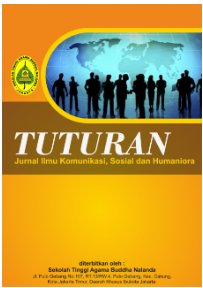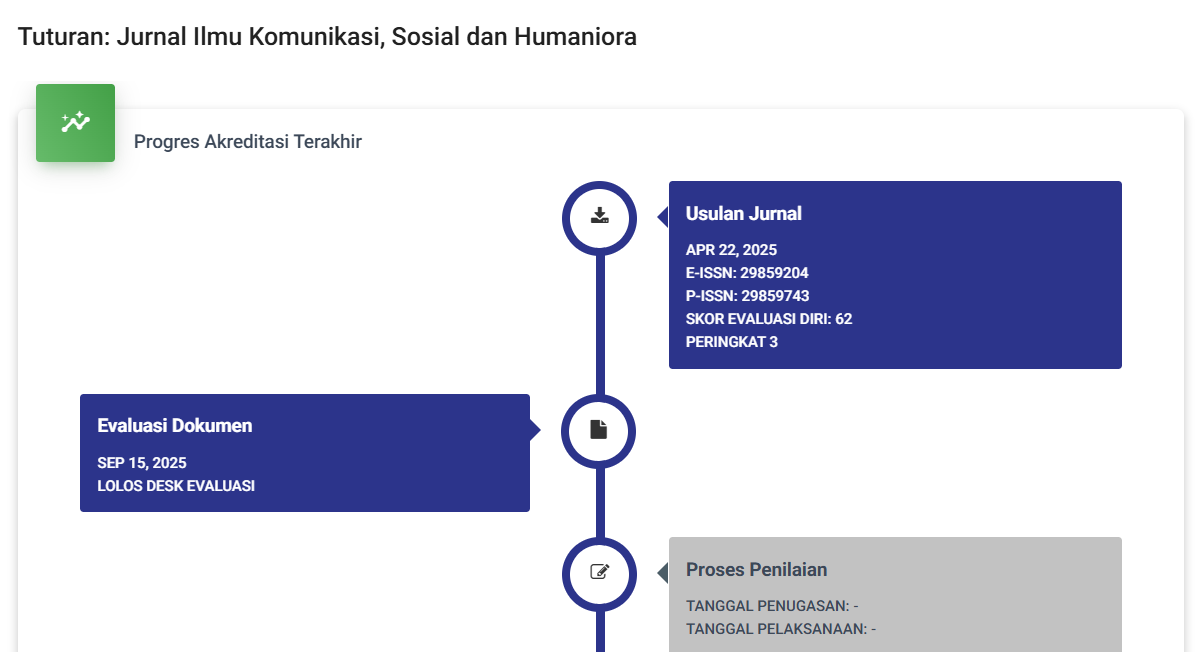Media Monitoring oleh Divisi Informasi di KJRI Johor Bahru
DOI:
https://doi.org/10.47861/tuturan.v2i4.1213Keywords:
media monitoring, KJRI Johor Bahru, information, communicationAbstract
This study aims to analyze the media monitoring activities carried out by the Information Division at the Consulate General of the Republic of Indonesia (KJRI) in Johor Bahru. These activities are crucial for understanding how information circulating in the media influences the image and policies of the KJRI, as well as identifying issues relevant to Indonesian citizens in Malaysia. The study employs a descriptive qualitative method with data collection techniques including direct observation, in-depth interviews, and document analysis. The results of the study indicate that the Information Division at KJRI Johor Bahru has implemented various effective strategies in media monitoring, including the use of digital tools to monitor various media platforms. KJRI Johor Bahru conducts Media Monitoring, referred to as Weekly Reports (Lapming), in accordance with the definition of media monitoring activities by Friedel and Lukman (2020). Meanwhile, media tracking at KJRI Johor Bahru involves monitoring various credible online news sources, and media clipping at KJRI Johor Bahru aims to organize news collected from online sources and social media.
References
Appel, G., Grewal, L., Hadi, R., & Stephen, A. T. (2020). The future of social media in marketing. Journal of the Academy of Marketing Science, 48(1), 79–95. https://doi.org/10.1007/s11747-019-00695-1
Atkin, C. K. (1972). Anticipated communication and mass media information-seeking. Public Opinion Quarterly, 36(2). https://doi.org/10.1086/267991
Bolger, D., & Houlding, B. (2016). Reliability updating in linear opinion pooling for multiple decision makers. Proceedings of the Institution of Mechanical Engineers, Part O: Journal of Risk and Reliability, 230(3). https://doi.org/10.1177/1748006X16631866
Choi, S. (2023). Measuring economic diplomacy using event study method: The case of EU-China summit talks and Airbus stock price changes. Asia Europe Journal, 21(2). https://doi.org/10.1007/s10308-023-00660-2
Davie, W. R., & Maher, T. M. (2006). Review and criticism: Research pioneer tribute—Maxwell McCombs: Agenda-setting explorer. Journal of Broadcasting & Electronic Media, 50(2). https://doi.org/10.1207/s15506878jobem5002_13
Dolan, R., Conduit, J., Fahy, J., & Goodman, S. (2017). Social media: Communication strategies, engagement and future research directions. International Journal of Wine Business Research, 29(1). https://doi.org/10.1108/IJWBR-04-2016-0013
Falah, R., & Setiawan, E. (2022). Aktivitas media monitoring bidang humas Badan Pengelola Keuangan Haji Republik Indonesia. Bandung Conference Series: Public Relations, 2(1). https://doi.org/10.29313/bcspr.v2i1.235
Fischer Data Science. (2024). What is media clipping?
Gamble, K. R., Cassenti, D. N., & Buchler, N. (2018). Effects of information accuracy and volume on decision making. Military Psychology, 30(4). https://doi.org/10.1080/08995605.2018.1425586
Gilboa, E. (2000). Mass communication and diplomacy: A theoretical framework. Communication Theory, 10(3). https://doi.org/10.1111/j.1468-2885.2000.tb00193.x
Goff, P. M. (2013). Cultural diplomacy. In The Oxford Handbook of Cultural Diplomacy. Oxford University Press. https://doi.org/10.1093/oxfordhb/9780199588862.013.0024
Isar, Y. R., & Triandafyllidou, A. (2021). Introduction to this special issue: Cultural diplomacy: What role for cities and civil society actors? International Journal of Politics, Culture and Society, 34(4). https://doi.org/10.1007/s10767-020-09385-1
Johansson, F., Brynielsson, J., & Quijano, M. N. (2012). Estimating citizen alertness in crises using social media monitoring and analysis. Proceedings - 2012 European Intelligence and Security Informatics Conference, EISIC 2012. https://doi.org/10.1109/EISIC.2012.23
Karafillakis, E., Martin, S., Simas, C., Olsson, K., Takacs, J., Dada, S., & Larson, H. J. (2021). Methods for social media monitoring related to vaccination: Systematic scoping review. JMIR Public Health and Surveillance, 7(2). https://doi.org/10.2196/17149
Kravchuk, N., & Nykolaichuk, M. (2023). The role of public diplomacy in the conditions of modern geopolitical and geo-economic fragmentation of the world. Innovative Economy, 3. https://doi.org/10.37332/2309-1533.2023.3.1
Laughlin Adler, B. (2006). Discovering differences in the nature of verbal and visual messages. Communication Teacher, 20(2). https://doi.org/10.1080/14704620600595610
Lazer, D. M. J., Baum, M. A., Benkler, Y., Berinsky, A. J., Greenhill, K. M., Menczer, F., Metzger, M. J., Nyhan, B., Pennycook, G., Rothschild, D., Schudson, M., Sloman, S. A., Sunstein, C. R., Thorson, E. A., Watts, D. J., & Zittrain, J. L. (2018). The science of fake news. Science, 359(6380). https://doi.org/10.1126/science.aao2998
Mijović, B., & Turčinović, F. (2018). Specific elements of the strategic advantages of the official and working languages in the international community. American International Journal of Social Science, 7(2). https://doi.org/10.30845/aijss.v7n2a5
Mukherjee, S., & Weikum, G. (2015). Leveraging joint interactions for credibility analysis in news communities. International Conference on Information and Knowledge Management, Proceedings, 19-23-Oct-2015. https://doi.org/10.1145/2806416.2806537
Protess, D. L., & McCombs, M. (2016). Agenda setting: Readings on media, public opinion, and policymaking. Routledge. https://doi.org/10.4324/9781315538389
Rawnsley, G. (1999a). Monitored broadcasts and diplomacy. In Innovation in Diplomatic Practice (pp. 135–150). Palgrave Macmillan UK. https://doi.org/10.1007/978-1-349-27270-9_8
Rawnsley, G. (1999b). Monitored broadcasts and diplomacy. In Innovation in Diplomatic Practice. Palgrave Macmillan. https://doi.org/10.1007/978-1-349-27270-9_8
Rossiter, J. R., & Danaher, P. J. (1998). Advanced media planning. Springer US. https://doi.org/10.1007/978-1-4419-8738-9
Saaida, M. B. E. (2023). The role of soft power in contemporary diplomacy. International Journal of Research Publication and Reviews, 4(4), 3119–3130. https://doi.org/10.55248/gengpi.4.423.36302
Sinnewe, E., Yao, T., & Zaman, M. (2021). Informing or obfuscating stakeholders: Integrated reporting and the information environment. Business Strategy and the Environment, 30(8). https://doi.org/10.1002/bse.2847
Sukmayani, O., & Jamroji, J. (2021). Media monitoring model in public relations of BUMN (state-owned enterprises) companies. Al-Mada: Jurnal Agama, Sosial, dan Budaya, 4(2). https://doi.org/10.31538/almada.v4i2.1284
Tanta, I., & Lesinger, G. (2015). Mediatisation or PR-ization of public--media communication: Analysis of mediated communication of Zoran Milanović. Collegium Antropologicum, 39(4).
Trust in automation as a function of transparency and teaming. (2019). Proceedings of the Human Factors and Ergonomics Society Annual Meeting, 63(1), 78–82. https://doi.org/10.1177/1071181319631212
Tsou, B. K. Y., Kwong, O. Y., Wong, W. L., & Lai, T. B. Y. (2005). Sentiment and content analysis of Chinese news coverage. International Journal of Computer Processing of Languages, 18(02). https://doi.org/10.1142/s0219427905001249
United Nations Development Programme. (2020). UNDP Annual Report 2020.
Uslu, S. (2024). Data-informed diplomacy: Adapting to the digital age in international relations and implementation in the OSCE region. In Contributions to International Relations: Vol. Part F2430. https://doi.org/10.1007/978-3-031-50966-7_14
Wang, Y., Cheng, Y., & Sun, J. (2021). When public relations meets social media: A systematic review of social media related public relations research from 2006 to 2020. Public Relations Review, 47(4). https://doi.org/10
Downloads
Published
How to Cite
Issue
Section
License
Copyright (c) 2024 TUTURAN: Jurnal Ilmu Komunikasi, Sosial dan Humaniora

This work is licensed under a Creative Commons Attribution 4.0 International License.








